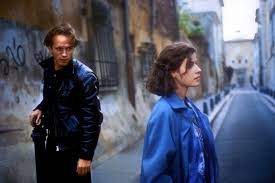Eye For Film >> Movies >> Beyond The Clouds (1995) Film Review

Beyond The Clouds is Michelangelo Antonioni’s final feature film, and showcases the venerable maverick’s directorial style at is best and its worst. He assembles a fine cast, ropes in Wim Wenders to help out on this tale of love, lust and naked women, and fails to make much use of any of his contributors successfully. Instead he pontificates, obsesses and ruminates for 110 minutes to varying degrees of success.
The film constitutes four short films, linked together by a story developed by Wenders in which a film director (John Malkovich) wanders around an Italian city musing on potential plots for his next feature. The four vignettes are based on short stories written by Antonioni, and all are to do with love and sex; from a man torn between his mistress and his wife, to a chance encounter in the street between two people that leads to a tempestuous passion, via a bit of obsessive stalking (which forms the back bone of the other two episodes).

An incredibly starry cast feature in these roles, and it’s a surprise that this doesn’t overwhelm the film. The reason why not is possibly that none of their roles are particularly interesting; Antonioni is more concerned with tone and ideas than developing characters or getting a good performance out of his ensemble. Fanny Ardant’s role never develops beyond that of a woman scorned, Irene Jacob is little more than a pretty innocent, while Jean Reno can probably be best described as ‘mysterious’ and not much else.
The only character of any interest is Malkovich, possibly because he is a thinly-veiled portrait of the director, was reportedly written by Wim Wenders and has the most screen time. However, like the other actors, he’s saddled with some stinking lines, howlers taken from The Big Book Of Art House Epithets. The tortured artist schtick does generally fail to illuminate proceedings.
However, the film is impeccably shot. It is visually gorgeous; there’s a scene in the rain in the last story, where the two characters stand outside in a street bathed in gold light that is just stunning. The sound editing is absolutely superb, from the lapping of waves through to the use of both accompanying soundtrack and more digetic music. The composition of shots is frequently artful, and the care and the sex scenes are tender (if a little bit pervy).
Its pace is also consistently, wonderfully languid. It’s old-fashioned tempo helps the images, sounds and also some of the ideas, time to breathe. Although often a little pretentious, the film is clearly fuelled by Antonioni’s obsessions concerning the thin lines between obsession and voyeurism, desire and baseness, and the place of sex in a relationship. Consequently there is a lot of good observation, interesting ideas and truth in the film that cement the piece’s status as more than a sensory pleasure.
A mixed success then; it’s an incredibly indulgent film that irritates and amazes in equal measure. A great cast is barely used in a heady, languid art house piece that is a sensory delight, a conversation starter, and pure Antonioni.
Reviewed on: 30 Sep 2009

















